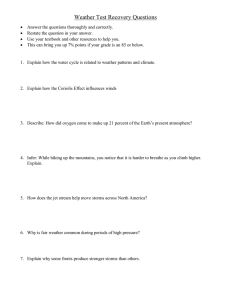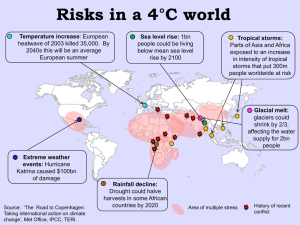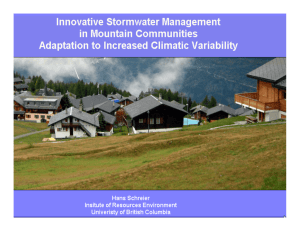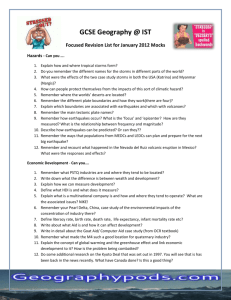Extreme Storms: Climatology of the
advertisement
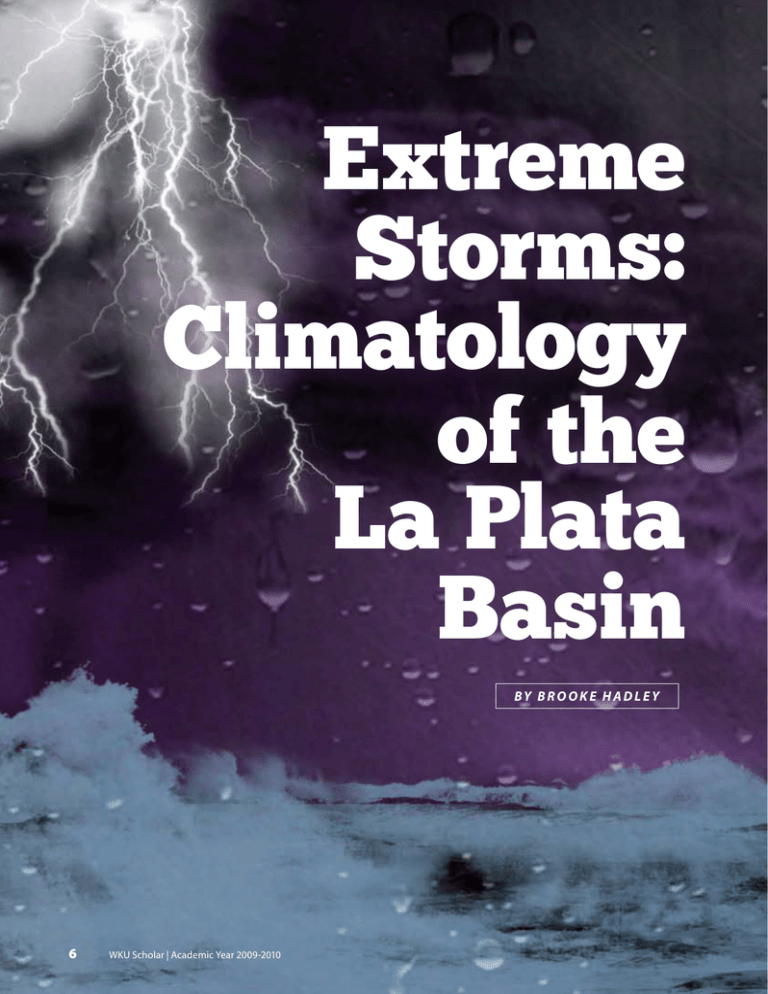
Extreme Storms: Climatology of the La Plata Basin By Brooke Hadley 6 WKU Scholar | Academic Year 2009-2010 Dr. Josh Durkee’s fascination with weather, especially severe storms, began at a very young age. “I remember when I was four. I was staying with my babysitter and a tornado came through the neighborhood. The other kids were scared, but I thought it was pretty cool. I knew that I wanted to learn more about severe weather events. I’ve known for a very long time that I wanted to do something weather-related, but I didn’t know I wanted to be an academic until I graduated from Western Kentucky University, with a bachelor’s degree in geography.” Durkee went on to earn a Master of Science and Ph.D. in geography at the University of Georgia. In 2008, he returned to Western Kentucky University to fulfill his dream of teaching meteorology and researching extreme weather and climate phenomena. “I don’t necessarily study just the hazards per se, but I tend to study the types of atmospheric events that create hazardous outcomes,” he explained. “For example, the number one convective weather-related fatality causing event is flash flooding. Subtropical South America experiences a high occurrence of large, long-lasting thunderstorm complexes — called mesoscale convective complexes or MCCs — that often produce prodigious widespread flooding rains but I realized that there were a limited number of studies in that region pertaining to these types of thunderstorms. The studies I found that pertained to these extremely large South American thunderstorms were typically short in scope, focusing on only one or two years, leading to a lot of speculation of the frequency and magnitude of these events. My goal became to develop an MCC climatology across the subtropical region of South America, which is prone to deadly flooding events.” Dr. Durkee achieved his goal. He developed a climatology of these particularly large, long-lived thunderstorms across the South American subtropical region, specifically the La Plata basin, which is the fifth largest river basin in the world. Climatology, unlike meteorology, which focuses on short-term weather systems, is the study of the frequency, trends, and longterm patterns of weather events over time in a specific region. Climatology can be used as a basis for weather forecasting or to build weather models. As a climatologist, Durkee has extensively studied the hydroclimate of the La Plata Basin region. “There are many factors that influence the formation of these massive storms in South America, some of which have spanned over one million square kilometers, but the primary factors are moisture and atmospheric instability,” said Durkee. To gauge the sheer size of these Josh Durkee “There are many factors that influence the formation of these massive storms in South America, some of which have spanned over one million square kilometers, but the primary factors are moisture and atmospheric instability.” WKU Scholar | Academic Year 2009-2010 7 “I am just beginning the next phase of my research. I plan to collaborate with people who work with numerical weather models to see what happens when environmental changes, such as the removal of the rainforest or an increase in global temperatures, take place. I believe there are huge implications for the removal of the rainforest.” storms, Kentucky is approximately one-hundred thousand square kilometers, so these storms cover an area ten times the size of Kentucky. “In the United States, we get a lot of our moisture from the Gulf of Mexico, and in South America the primary source of moisture is the Amazon rainforest even though they have oceanic sources too. However, the water vapor from the rainforest can be double what the oceans provide. In addition, the Andes Mountains provide cold upperatmosphere temperatures, while the rainforest provides a relatively warm, humid lower atmosphere,” he explained. “Storms like these can develop quickly with rapid vertical changes in temperature. The more extreme the vertical changes in temperature, the greater the potential for an extreme storm. It is the geography of the La Plata Basin that helps provide prime conditions for the onset of these types of storms. Typically, these thunderstorm complexes begin as a group of smaller, individual storms that later merge into one larger thunderstorm complex that typically lasts for fourteen hours. The rain from just one of these large storms could fill up an area the size of the state of Kentucky with nearly 2.5 inches of water during that time.” Durkee continued, “These storms are often linked to flash flooding; those people who don’t die in flash floods may also be prone to disease from the devastation resulting from persistent regional flooding. This was the case during the 2006-07 warm season across much of Paraguay.” LA PLATA BASIN EQ 5S 10S 15S 20S PY 25S 30S UP MP Sub-basins LP UY 35S UP: Upper Parana MP: Middle Parana LP: Lower Parana PY: Paraguay UY: Uruguay 40S 85W 80W 75W 70W 65W 60W 55W 50W 45W 40W 35W 30W 25W 8 WKU Scholar | Academic Year 2009-2010 The unusual part of Dr. Durkee’s research is that he’s never been to South America. “I use remote sensing data. I am able to do this because it’s the only thunderstorm that is identified by its cloud attributes. Many thunderstorms are identified by radar attributes. In this case, the storms are so big that we look at the size, shape, and temperature of the clouds and how long the storm persists. That’s truly what identifies these storms. That makes it easier to use satellites to find these types of cloud systems. Then we can catalog those events. Another aspect about looking at the rainfall in South America is that a lot of their weather data is not as developed as in the United States. There are tremendous variations of the quality and availability of data, since the data span numerous countries. Whereas here in the United States we have rain gauges all over the state, in my study region there might be a hundred miles between rain gauges. I am able to use satellites to estimate the rainfall,” said Durkee. The use of technology to study South American climate appeals to Dr. Durkee’s students. “Most people who think about severe weather think about the Great Plains and general storm activity in the United States, but there are many places where the storms can easily trump North America. When I discuss storms in South America, my students usually respond that they’ve never thought of severe weather in that area. I think what’s fun for me is that while I study severe weather phenomena in the United States, I have also developed a research platform in South America and I can expose my students to MCC: Color-enhanced infrared satellite image (left) and radar reflectivity (right) of a particularly large, long-lived thunderstorm complex, known as a mesoscale convective complex (MCC), over the central U.S. during April 24, 2006. weather events in other countries they haven’t thought of studying before. I have a real example to show my students how various technologies can be used to study climate almost anywhere. They really get into that.” Although the process is lengthy and involves multiple stages, Dr. Durkee’s climatology of the La Plata basin could eventually lead to the development of enhanced weather models and forecasting of these large storm systems, providing the residents of the basin with valuable information and warning before the storms occur. “I am just beginning the next phase of my research. I plan to collaborate with people who work with numerical weather models to see what happens when environmental changes, such as the removal of the rainforest or an increase in global temperatures, take place. I believe there are huge implications for the removal of the rainforest; if you remove it you strip away the primary moisture source and perhaps the frequency and severity of these storms decreases. That might sound good, but these storms are very important to the La Plata Basin. They provide essential rainfall for agriculture, which many people depend on for their income, and hydroelectric plants, which are a large source of electrical energy for much of subtropical South America,” said Durkee. “There’s a delicate balance. When MCCs occur on average, not too big or too often in one area, they’re actually a great resource for both agriculture and power generation.” In addition to studying climatology, Dr. Durkee, while at the University of Georgia, also studied “Most students only get to work out of the book or with computer simulations and graduate with little practical experience. One of my goals at Western Kentucky University is to provide hands-on experiences to the students.” the impact and effectiveness of geography education. “While working on my Master’s thesis, I realized the lack of engaging and interactive activities undergraduate students often experience. Most students only get to work out of the book or with computer simulations and graduate with little practical experience. One of my goals at Western Kentucky University is to provide hands-on experiences to the students.” “In the classroom, students typically enjoy talking about severe weather. Everyone has a severe weather story. It’s awe inspiring. Students want to learn more about severe weather,” said Durkee. “I can use my research to encourage students’ interests and give them more of an opportunity to research storms first-hand in the field. WKU is very encouraging and open to developing a more interactive approach to provide these authentic experiences.” Currently, Dr. Durkee is working on developing a more hands-on approach to teach meteorology and climatology, including developing a class in which students would spend several weeks in the field studying severe weather and chasing storms. n WKU Scholar | Academic Year 2009-2010 9
